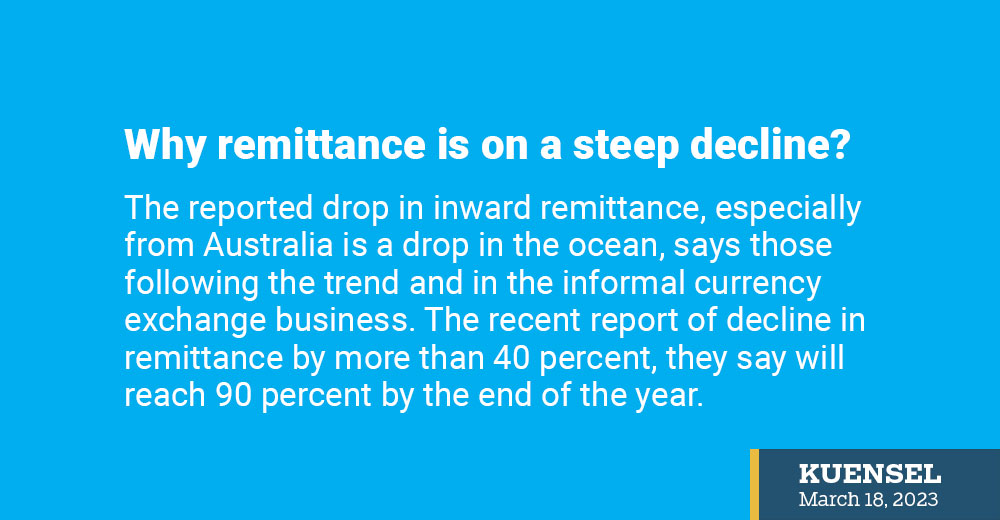Better exchange rates, chain migration, and rush for CC stop dollars from coming home
Rinzin Wangchuk
The reported drop in inward remittance, especially from Australia is a drop in the ocean, says those following the trend and in the informal currency exchange business. The recent report of decline in remittance by more than 40 percent, they say will reach 90 percent by the end of the year.
The Australian Dollar (AUD) is circulating in Australia with only a trickle reaching home through formal banking channels. With better exchange rates offered, informal currency exchange is picking up. Hundreds are on social media networking Apps connecting sellers and buyers. The rates offered are two to three Ngultrums higher.
The so-called money traders offer Nu 59 to 60 for one AUD whereas banks in Bhutan buy at Nu 54.10 and sell at Nu 55.60 for one AUD as of yesterday. “If somebody in Australia wants to raise AUD 100,000, it is not difficult,” said a trader. “Everybody pools in because the exchange rate is better.”
Given the informal currency exchange market is thriving in Australia, USA, India, Thailand, Japan and Singapore, Bhutan is expected to witness a steady drop in convertible currency (CC).
RMA initiatives, not attractive?
In May 2021, the Royal Monetary Authority (RMA) introduced cash incentives to encourage Bhutanese overseas to offset the transaction costs while sending money to their personal accounts or to their family members in Bhutan. The incentive was increased from one percent to two percent for inward remittance from June last year until December this year.
Under the scheme, beneficiaries received cash incentives of two percent upon converting the remitted amount in Ngultrum using the prevailing exchange rates through banking channels and international money transfer operators. Bhutanese living abroad can also maintain foreign currency accounts and earn interest on foreign currency deposits offered by the commercial banks.
However, this has not attracted Bhutanese abroad to remit money home.
A former journalist working on temporary resident visa (TRV) in Perth said that it is better to sell AUD in Ngultrum in Perth because of the higher rates. For example, according to her, the central bank’s buying rate in Bhutan is Nu 54.10 for AUD, as of yesterday, but she can sell at Nu 59 or Nu 60. “There are many looking for AUD here and rates could get better.”
Doing her calculations, she said a relative in Bhutan receives Nu 55,182 including Nu 1,082 as incentives when AUD 1,000 is remitted with a transaction fee of AUD 12, about Nu 649.2 per transaction. “By selling AUD 1,000 in Australia, the exchanged amount comes to Nu 59,000 or Nu 60,000. The money can be transacted within seconds through banking Apps like MBoB or MyPay.”
Time taken to send money home is another factor even if not significant. It takes about four to five working days to credit money in their account through TpayRemit, according to Bhutanese in Australia. “Moreover, it is difficult to generate pin code as the system is down most of the time. Such challenges discourage us from sending money to Bhutan,” she told Kuensel.
Officials from T-Bank confirmed the decline in remittance, especially from Australia. “Due to decline in AUD exchange rate, we are receiving less transactions through T-PayRemit,” an official said, clarifying that the dealing staff are crediting the transactions on the same day if the transactions are received during banking hours.
Until recently, T-Bank was the most popular remittance channel for Bhutanese in Australia and the Middle East. T-Bank through its T-Pay Remit and Prabhu Money Transfer received 50.25 percent of the total remittances from Australia, 9.45 percent from the Middle East and 4.43 percent from the US in 2022. Through Ria Money Transfer and BoBit, Bank of Bhutan received 12.03 percent from the US, 3.92 percent from Australia and 2.51 percent from the Middle East.
Bhutan Post received 9.9 percent and 4.2 percent from the US and Middle East through Western Union and EuroGiro. Bhutan National Bank received 9.89 and 3.93 percent remittances from the US and Middle East through Ria Money Transfer and MoneyGram.
Chain migration and hard currency?
A Bhutanese living and working in Perth, WA, paid AUD 18,000 directly to the university in tuition fees for another Bhutanese coming to Australia. The equivalent amount in Ngultrum was deposited in his account. This was a win-win situation except that the AUD remained in Australia.
This is the trend as the Australian rush continues. What could be a chain migration, the ability of Bhutanese in Australia to sponsor family members, relatives, friends and those looking for AUD to pay for insurance and tuition fee, is blocking the AUD from coming home.
Hundreds of Bhutanese, it is said paid their tuition and visa fees in AUD without having to worry about not getting hard currency. A good side is the pressure on hard currency reserves is reduced, according to a finance expert working in one of the financial institutions.
Annual Travel Scheme
The RMA’s Annual Travel Scheme (ATS) modality is also being blamed. A businessman familiar with currency trading said that although Bhutanese living abroad can maintain foreign currency account and earn interest in foreign currency, the RMA restrictions discourages people from sending dollars home.
“Even if I have USD 50,000 in my dollar account, I can only avail USD 3,000 in a year with the ATS modality in Bhutan. “We do not have control of our own money,” he said. “Such policy should be removed.”
The central bank recently reviewed the ATS modality whereby residents travelling to third countries are permitted to avail USD 1,000 in cash and USD 2,000 in cards (both international credit and debit cards) per year.
Meanwhile, from Nu 8.06 billion or USD 108.74 million in 2021, inward remittance almost halved with Nu 4.69B or USD 61.66M coming in 2022. The inward remittance contribution to the country’s total CC inflow stands at 21 percent and 23 percent in 2020 and 2021 respectively, according to RMA.


